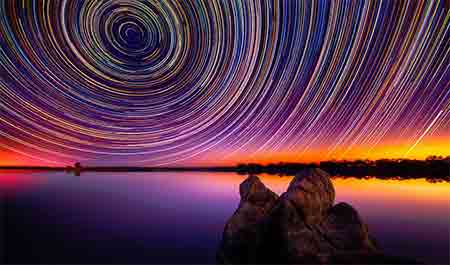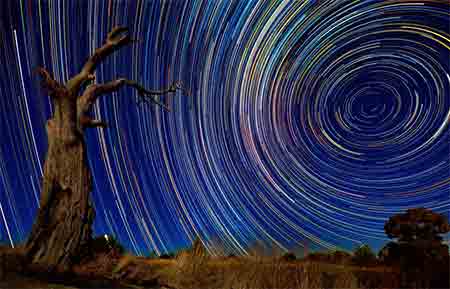
Updated to include Comments, and the Photographer’s Response:
Photographing star trails is always a bit of an endurance test. Long, usually solitary hours in the dark, and often on wintry cold nights, are required obstacles to overcome. The results of such late-night shooting are sometimes, well, less than stirring.
The art and craft of star trail shooting reach new visual heights with the work done by Australian photographer Lincoln Harrison. Many are taken over Lake Eppalock near Bendigo in Victoria, Australia
Usually, the arc of star trails is fairly short, depending on the exposure duration, and the latitude. The more sweeping arcs captured in these shots are more compositionally pleasing, even and perhaps especially, when they are slightly uneven due to miniscule camera movements as seen here below in ‘Ghostly’.

I have found a few posts about his work, and working methods.
According to the Daily Mail article, he bought his first camera, a Nikon D3100, to do eBay product shots only last year. Gives one a pang, doesn’t it? that he just started shooting?
Lincoln Harrison photographer’s website
Extremely long exposure from the Daily Mail
Beautiful Photographs of Star Trails Above Australian Outback
Enjoy.
PhotographyUNcapped reader Steverino commented and asked questions in the Comment section below. I forwarded them to the photographer, Lincoln Harrison, and have added the questions , and his responses here:
“For 15 hr. exposures the grass and tree outlines are surprisingly sharp”
15 hours is the total time of the ‘NightShift’ shoot (the image at the top of this page, my image titles got mixed up at some point), its not a single 15hr exposure. The image is made up of 720 x 60 second shots of the stars (taken on the winter solstice – 12 hours of darkness), and one shot taken during afternoon twilight – all the foreground details come from this shot only, thats why the grass isn’t blurred. I also shot morning twilight but didn’t use those images. All the shots are stacked together in CS5, these details were provided to the Daily Mail but they didn’t print them, the article did give the impression that they are single exposures.
“Why don’t at least some of the star trails, if not most, overlap?”
No idea. I think the brighter one would just hide the other one if they did due to the image stacking process.
”There is inconsistancy in the shape of the orbits, some circular, some eliptical and different directions. Wouldn’t they all be circular, reflecting the rotaion of the Earth?”
There’s 2 things going on here, I’m shooting at 10mm so I get UWA lens distortion (and sometimes fisheye lens distortion with or without lens correction), the effect will look different depending on where the centre of rotation is placed in the frame, when near the edges it is more extreme. The earth’s atmosphere also causes distortions in how we see the sun, moon and stars. Google “differential atmospheric diffraction” if you want to know more about how it works.
“Why are only some of the star paths reflected on the water? Mirrors are not selective.”
Only the brighter stars will cast a reflection, and the water has to be perfectly still, if its only still for 2 hours of an 8 hour shoot you’ll only get reflections from the stars that passed the reflected area of the sky during that 2 hours, and no reflections for the other 6 hours. That’s basically what happened with the 2 images with reflections in the daily mail article, they were shot at the same time and place so the same stars are reflected in both. A few hours into the shoot a light breeze started blowing and I lost the reflections.
Thanks.
Lincoln.
Thanks to Steverino, and Lincoln for the additions.
Bieutiful “images.” There are some inconsistencies, some of which are brought up in the comments in the Daily Mail article. For 15 hr. exposures the grass and tree outlines are surprisingly sharp. After further examination I came up with some others.
Why don’t at least some of the star trails, if not most, overlap?
There is inconsistancy in the shape of the orbits, some circular, some eliptical and different directions. Wouldn’t they all be circular, reflecting the rotaion of the Earth?
Why are only some of the star paths reflected on the water? Mirrors are not selective.
Hope I did’t ruin anyone’s evening.
The photgraph never lies.
Steverino, did you see the photographer’s responses in the updated post above?